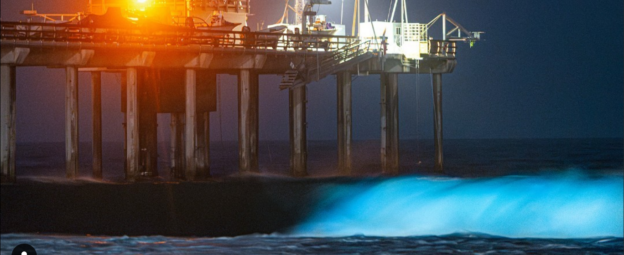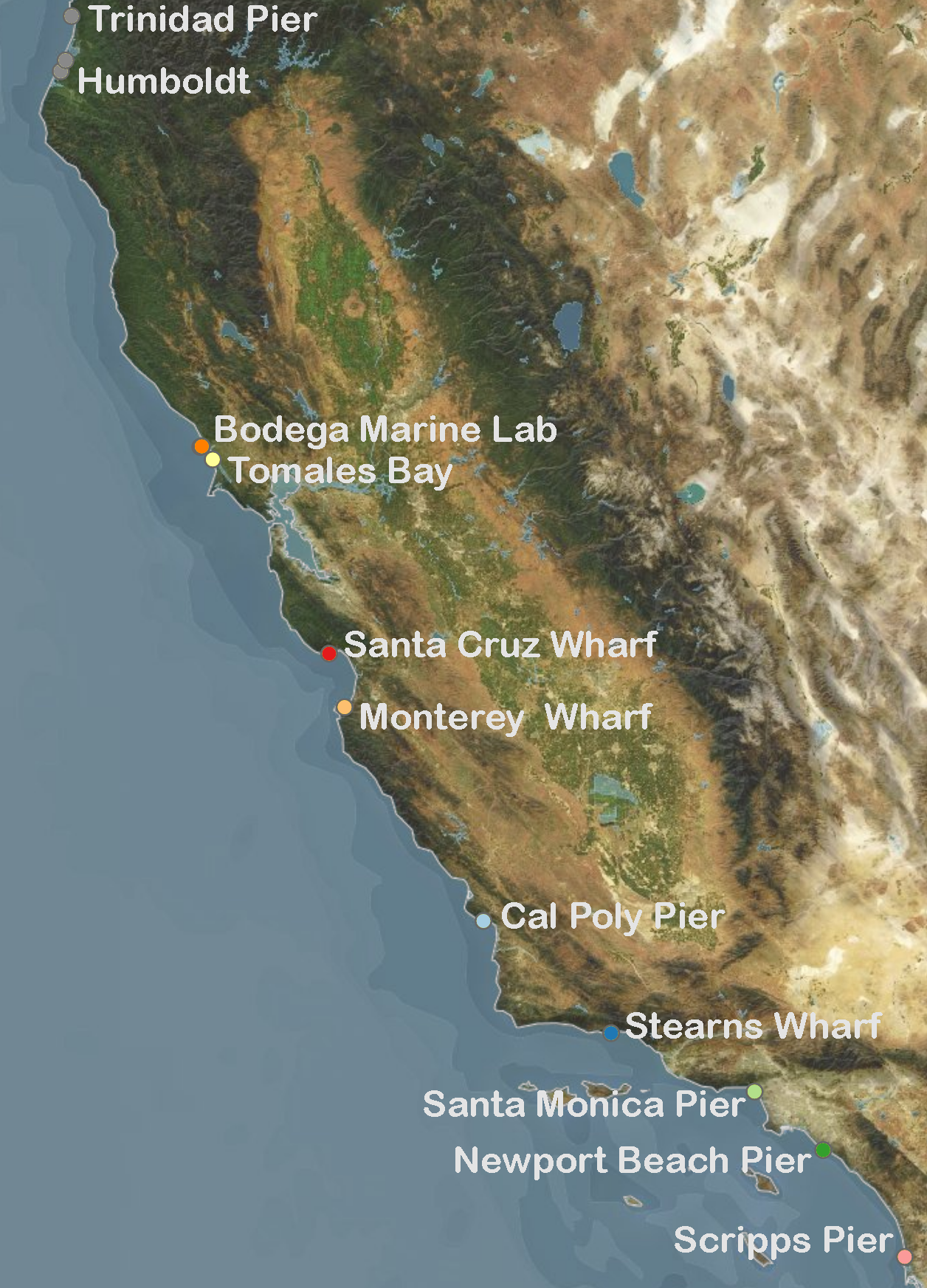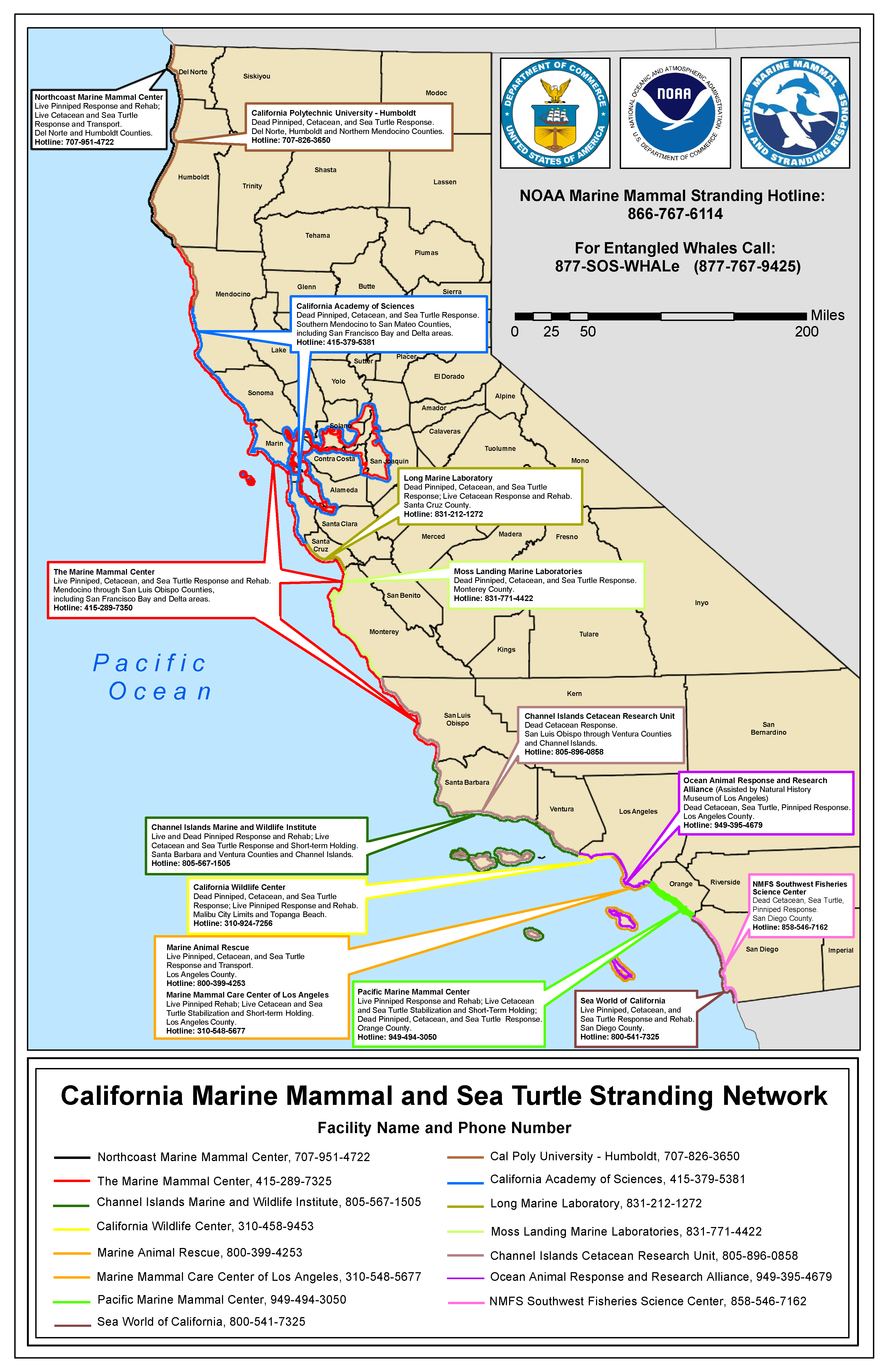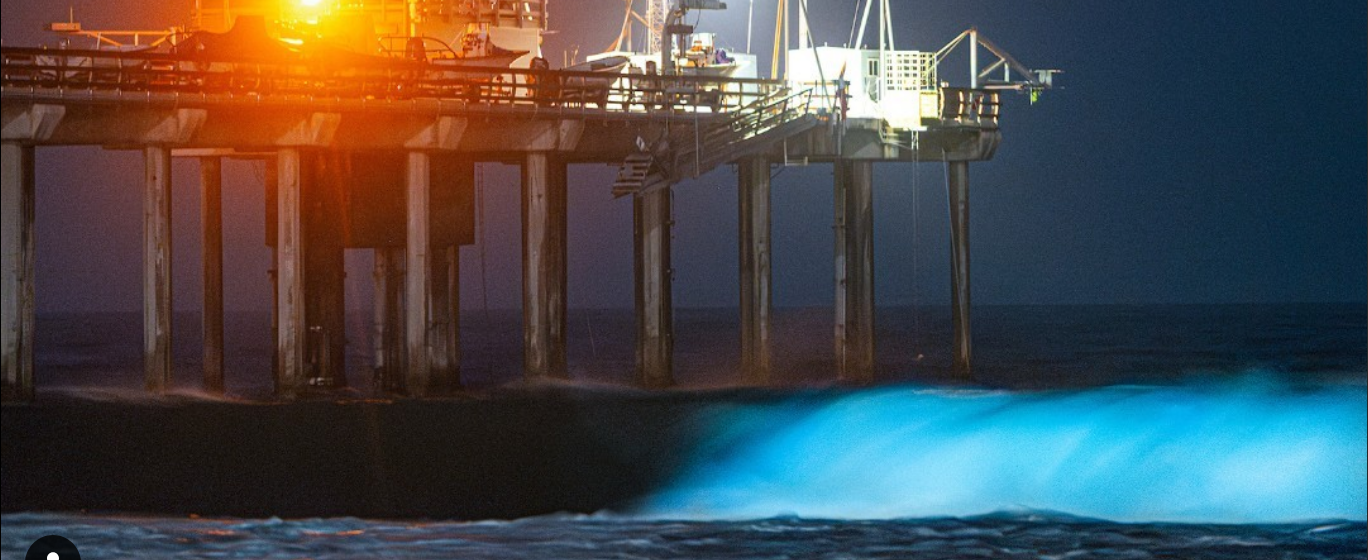October 2024
Summary written by Dr. Clarissa Anderson, 23 December 2024
– HAB Bulletin v2 –
The team welcomes any and all feedback on this new format of the California Harmful Algal Bloom bulletin, and extend our gratitude for your continued patience as we work through delays in development & data availability.- SUMMARY: At the beginning of October, over ten Ca Sea Lion stranding cases in central California and fewer peppered throughout southern California seemed to be spillover from the September domoic acid (DA) resurgence. There is a slight indication of mid-month bloom conditions at some nearshore sites and scattered high-DA conditions in northern California where the Dungeness crab fishery opening was delayed in November due, in part, to high levels of DA.
- The C-HARM predictions for particulate domoic acid (DA) showed scattered offshore patches of high probability across much of California early in October. By mid October, coastal central California was predicted to have very high pDA event risk, and this waned by the end of October, with high probabilities hugging some very nearshore coastal zones statewide. Predictions of the cellular fraction of DA suggested highest risk confined to patches along the coast form Pt. Conception to the Oregon border earlier in the month of October, weakening to medium risk by the end of the month, somewhat consistent with Dungeness crab fishery delays in November associated with DA risk. Bloom levels of Pseudo-nitzschia cells were predicted to be highest from mid to end of October along the central coast but with no concomitant DA measurements or associated impacts in that region.
- The view from CalHABMAP dada at the piers showed bloom levels of the smaller, less toxigenic “delicatissima” size class of Pseudo-nitzschia at Newport Beach Pier and the larger, more toxigenic size class “seriata” (along with relatively high DA levels) at Stearns Wharf, Santa Barbara in late September. Bloom levels of the “delicatissima” size class were just met at Newport Beach Pier and almost met at Scripps Pier in San Diego in mid October. The “seriata” size class approached bloom levels at Newport Beach Pier and Stearns Wharf (with low DA concentrations) in mid-October. The only other site where Pseudo-nitzschia cells were observed in October was Bodega Marine Laboratory, with non-bloom levels in mid-late October. No DA was detected at any HABMAP site except Stearns Wharf in October.
- Time series of automatic images from robotic microscopes (IFCBs) classified to the genus level did not capture Pseudo-nitzschia activity at Santa Cruz Wharf — mostly the dinoflagellates, Akashiwo and Prorocentrum. The same was true for Scripps Pier – mostly the dinoflagellates, Prorocentrum and Lingulodinium polyedra – and no Pseudo-nitzschia, which is inconsistent with HABMAP manual sampling, which picked up moderate abundances of P. “deli” class cells at Scripps Pier in October. Indeed, the time series of the Pseudo-nitzschia spp. class at Stearns Wharf from the machine learning model shows non-detectable levels for the entire month of October, counter to HABMAP sampling at that site. As reported in the last bulletin, this is an active area of research for our team to better understand the discrepancy.
- The state of California’s phytoplankton sampling results are somewhat consistent with the HABMAP pier observations. Relative abundance of Pseudo-nitzschia “seriata” was recorded as “Common” at San Luis Obispo and Santa Barbara sites in early October and then as “Abundant” in Santa Barbara in late October, consistent with cell counts approaching bloom levels at the HABMAP Stearns Wharf location. Only low levels were observed at San Diego sites, unlike the HABMAP results. “Common” levels were noted at the northern Del Norte site in mid-October, which is relevant considering the subsequent CDPH advisory on Nov. 1 to not eat sport-harvested Dungeness Crab from the Oregon border to Reading Rock State Marine Reserve as well as the delay in the commercial Dungeness crab fishery opening in northern California in early November. The advisory was later expanded to Pt Reyes. CDPH advisories for domoic acid risk in bivalves in Santa Barbara County were issued in response to the DA event in September but were lifted on October 23rd just before the annual recreational mussel quarantine was lifted on October 30th.
- Marine mammal strandings from suspected DA toxicosis/intoxication continued to be higher than background levels into early October after the local peak in September and following a much larger event in August. Most of the animals were collected by The Marine Mammal Center of Sausalito and thus had a central California stranding origin. The rest of the recorded cases were from Santa Barbara and southern California centers. No animals were reported as stranded with symptoms of DA poisoning at the end of October, which suggests that the bloom levels observed at the coast in southern California were perhaps confined to the nearshore zone and/or were too ephemeral or nontoxic to lead to impacts in marine mammal populations (as predicted by the C-HARM model at the end of the month).
- Alexandrium spp. were active in October according to the HABMAP pier sampling, with elevated levels recorded at Santa Cruz Wharf (early Oct) and Bodega Marine Laboratory (mid-end Oct). This is in stark contrast to CDPH phytoplankton monitoring results that indicate Alexandrium spp. were either Rare or Absent at all California sites sampled. The Paralytic Shellfish Poisoning (PSP) advisory for sport-harvested shellfish from Sonoma and Humboldt Counties was lifted on October 8th but not in Marin and Monterey Counties until Nov. 12th.
Particulate Domoic Acid
Particulate domoic acid (pDA) is the measurement of total domoic acid toxin that is potentially extant in a given area. This forecast provides a probability for where that concentration of toxin is predicted to exceed the threshold that classifies a Harmful Algal Bloom (> 500 nanograms per liter).
The C-HARM v3 model generates nowcast and forecasts of the probability of Pseudo-nitzschia concentrations of in excess of 10,000 cells/L, the probability of particulate domoic acid > 500 nanograms/L, and the probability of cellular domoic acid > 10 picograms/cell in California and Southern Oregon coastal waters. Inputs for the model include near real-time satellite observations, gap-filled chlorophyll a, 486nm reflectance, and 551nm reflectance fields from the S-NPP NOAA VIIRS sensor plus nowcast and forecast data of surface salinity, sea surface temperature, and surface currents from WCOFS ROMS.
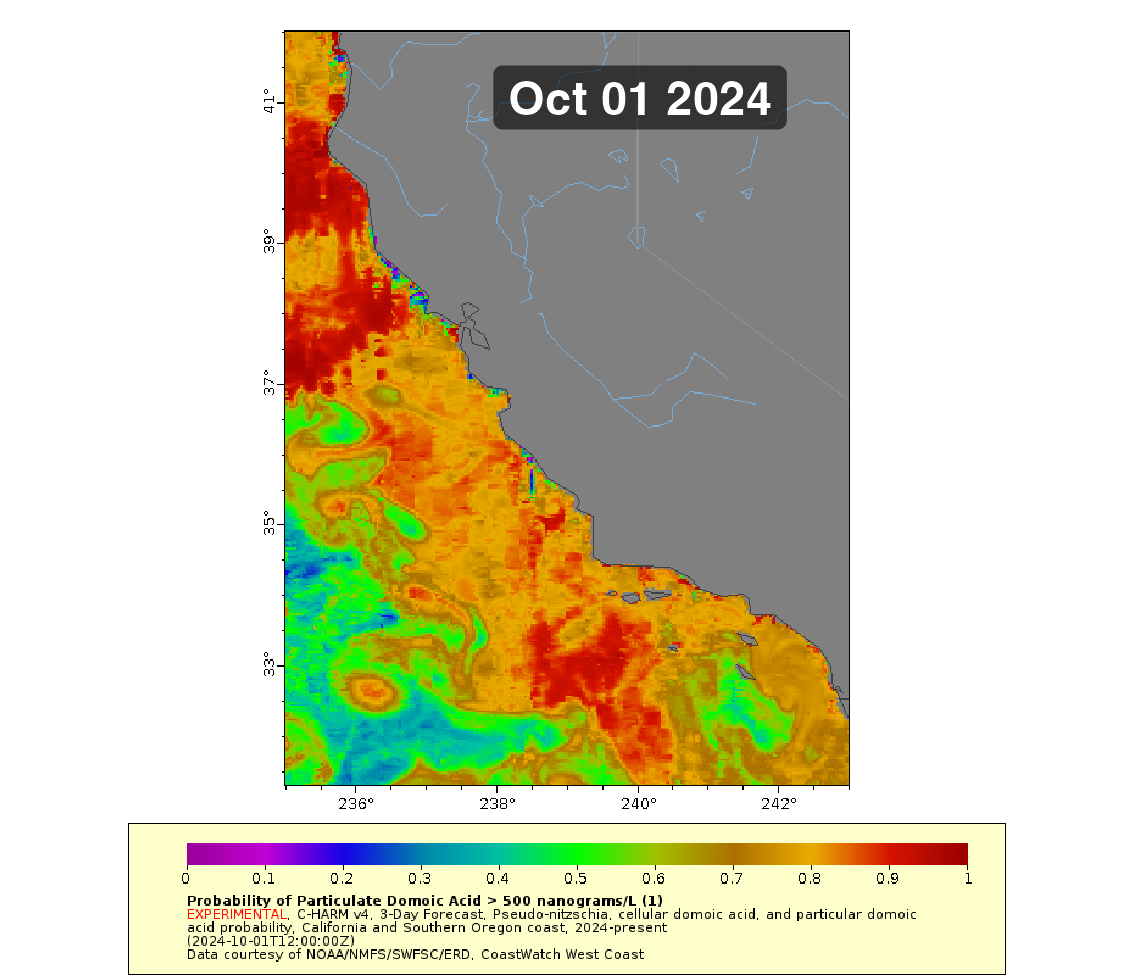
Cellular Domoic Acid
Cellular domoic acid (cDA) is the measure of total domoic acid toxin calculated per cell of Pseudo-nitzschia. This forecast provides a probability for where those cells are expected to be producing toxin at high levels (> 10 picograms per cell).
The C-HARM v3 model generates nowcast and forecasts of the probability of Pseudo-nitzschia concentrations of in excess of 10,000 cells/L, the probability of particulate domoic acid > 500 nanograms/L, and the probability of cellular domoic acid > 10 picograms/cell in California and Southern Oregon coastal waters. Inputs for the model include near real-time satellite observations, gap-filled chlorophyll a, 486nm reflectance, and 551nm reflectance fields from the S-NPP NOAA VIIRS sensor plus nowcast and forecast data of surface salinity, sea surface temperature, and surface currents from WCOFS ROMS.
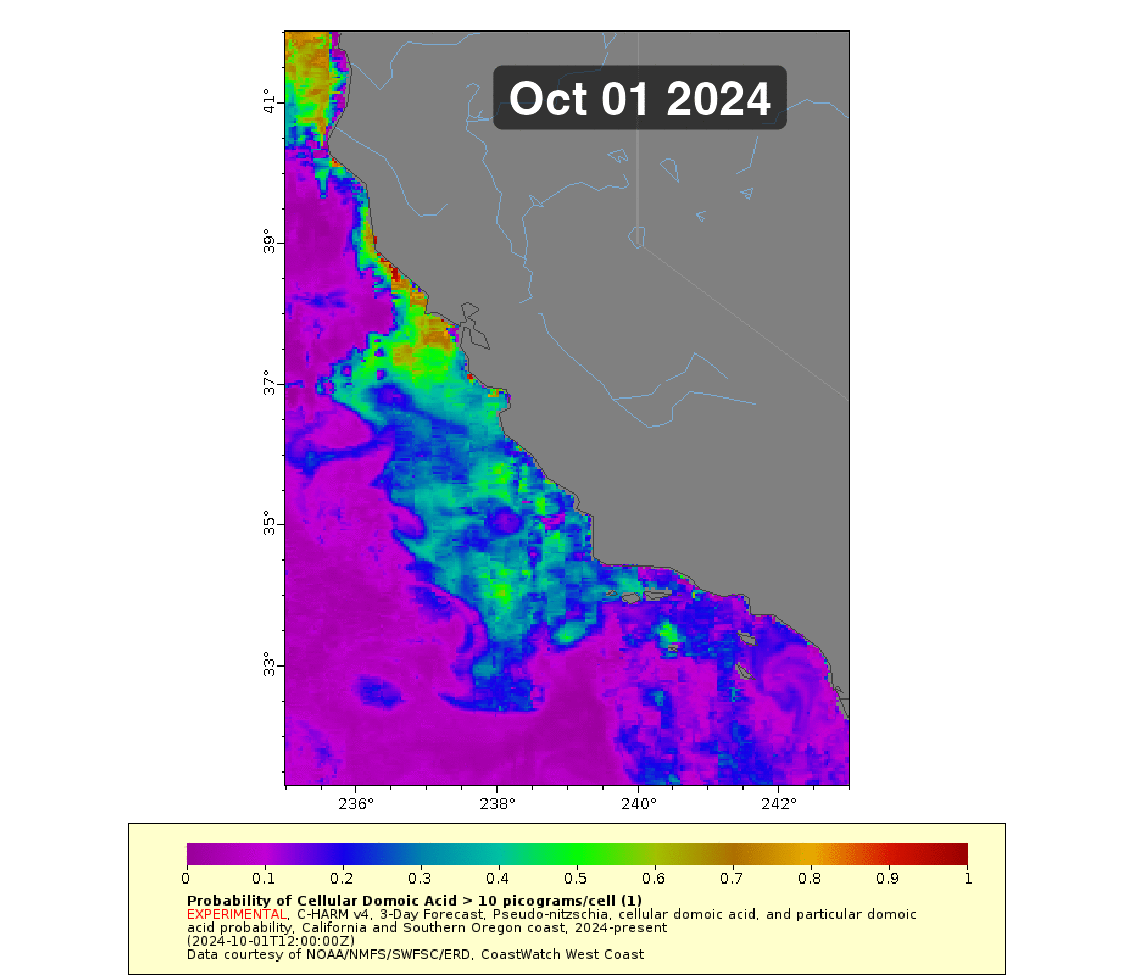
Pseudo-nitzschia
Pseudo-nitzschia is a neurotoxin producing diatom that is observed along the California Coast. Blooms of this phytoplankton can be detrimental to surrounding marine ecosystems. This forecast provides a probability for where the concentration of cells in the water exceed the threshold of a Harmful Algal Bloom ( > 10,000 cells/L).
The C-HARM v3 model generates nowcast and forecasts of the probability of Pseudo-nitzschia concentrations of in excess of 10,000 cells/L, the probability of particulate domoic acid > 500 nanograms/L, and the probability of cellular domoic acid > 10 picograms/cell in California and Southern Oregon coastal waters. Inputs for the model include near real-time satellite observations, gap-filled chlorophyll a, 486nm reflectance, and 551nm reflectance fields from the S-NPP NOAA VIIRS sensor plus nowcast and forecast data of surface salinity, sea surface temperature, and surface currents from WCOFS ROMS.

California Harmful Algal Bloom Monitoring & Alert Program
Differentiating Pseudo-nitzschia species by light microscopy is difficult. For this reason, Pseudo-nitzschia “seriata” does not refer to an actual species but rather the larger size class of Pseudo-nitzschia, which is generally a more toxigenic group of species. Alternatively, Pseudo-nitzschia “delicatissima” refers to the smaller size class that is generally non-toxigenic. The dashed line on the plots demarcates the 10,000 cells/L “bloom” threshold designated here for Pseudo-nitzschia populations only.
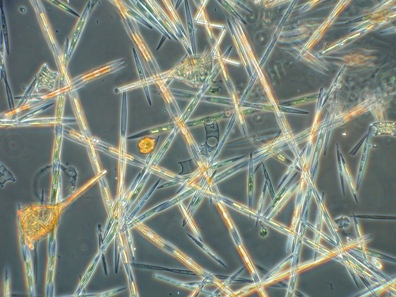
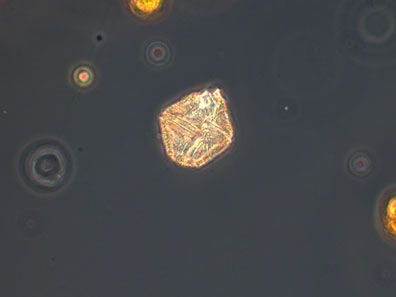
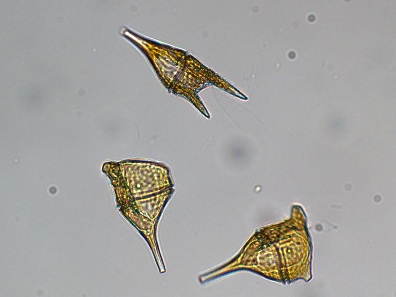
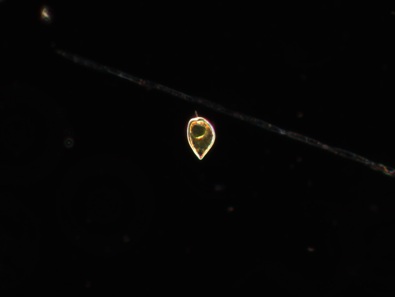
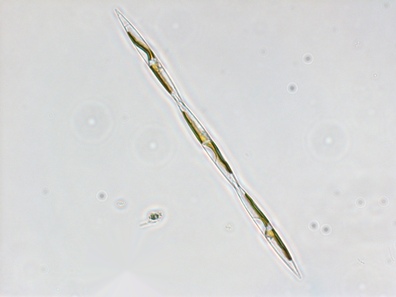
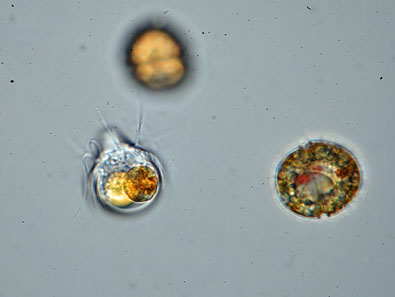
These time series focus on data collected through the scope of this bulletin and the 12 month period that precedes it. Explore the variables and regions that make up the CalHABMAP collective dataset using the plot controls.
More information and data visualizations on the statewide HAB network and forecasting system is found on the California HABMAP website and on the SCCOOS Harmful Algal Bloom page.
A network of Imaging FlowCytobots (IFCBs) continuously photographs particles, such as plankton, in the water. Using machine learning, plankton species can be automatically identified. This will help improve the ability to detect and respond to Harmful Algal Blooms, including the ability to assess conditions that may lead to toxin production or blooms of toxin-producing algae.
These data, coupled with the image classification algorithms developed in collaboration with SCCOOS and CeNCOOS, allow for estimates of species composition over time. The time series below depict sampling outcomes across several California sites. Support provided by NOAA IOOS and CA OPC.
Additional images and data are available on the IFCB dashboard. NOTE: Eight shore station and offshore mooring sites are equipped with IFCBs, and five were generating data in September.]
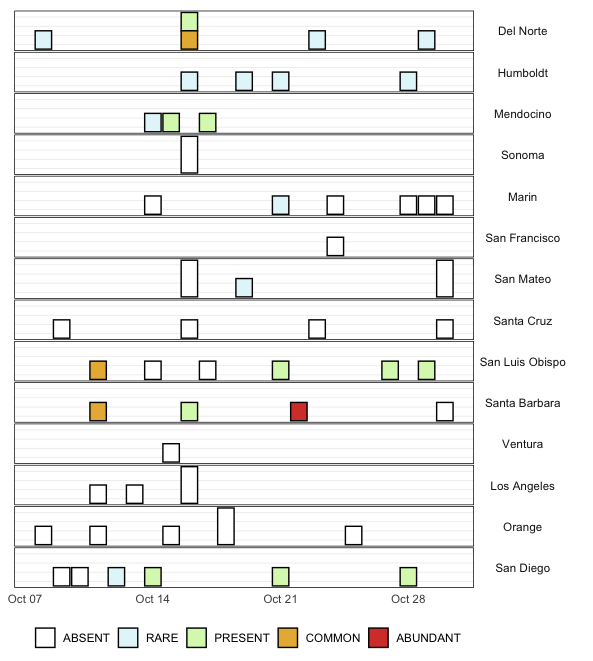

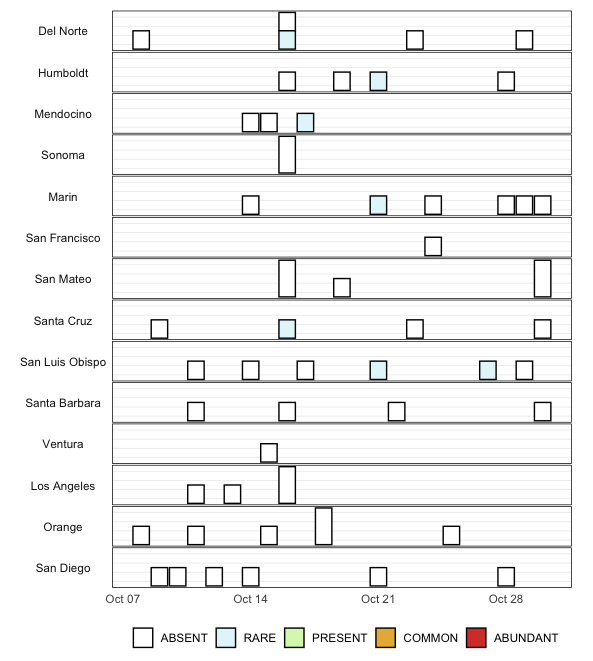
Each month, water samples are collected by volunteers and sent to the California Department of Public Health (CDPH) for analysis.
The relative abundance of DA-producing Pseudo-nitzschia ‘seriata’ size class (left) and PSP toxin-producing Alexandrium spp. (right) are catalogued from sample locations (middle) within each county.
____
CDPH lifts their consumption warning of sport-harvested bivalve shellfish in Humboldt County.
____
CDPH lifts their consumption warning of sport-harvested bivalve shellfish in Santa Cruz & Santa Barbara County.
____
Statewide annual quarantine on mussels ends for all coastal counties except Del Norte, Marin & Monterey.
Water Sample Detailed Data
| Date_Sampled | County | Sample_Site | PN_Percent_Comp | PN_Density | AL_Percent_Comp | AL_Density |
|---|---|---|---|---|---|---|
| 2024-10-08 | Del Norte | Wilson Creek | 0.5 | RARE | 0 | ABSENT |
| 2024-10-08 | Orange | Newport Bay, Back Bay | 0 | ABSENT | 0 | ABSENT |
| 2024-10-09 | Santa Cruz | Santa Cruz Wharf | 0 | ABSENT | 0 | ABSENT |
| 2024-10-09 | San Diego | Imperial Beach Pier | 0 | ABSENT | 0 | ABSENT |
| 2024-10-10 | San Diego | San Diego Bay, U.S. Navy Pier | 0 | ABSENT | 0 | ABSENT |
| 2024-10-11 | Santa Barbara | Santa Barbara Ch., Naples Pt | 15 | COMMON | 0 | ABSENT |
| 2024-10-11 | San Luis Obispo | Port San Luis, Diablo Cove | 10 | COMMON | 0 | ABSENT |
| 2024-10-11 | Orange | Bolsa Chica | 0 | ABSENT | 0 | ABSENT |
| 2024-10-11 | Los Angeles | Palos Verdes Rocky Pt Offshore | 0 | ABSENT | 0 | ABSENT |
| 2024-10-12 | San Diego | Pacific Beach Pier | 0.5 | RARE | 0 | ABSENT |
| 2024-10-13 | Los Angeles | Catalina Island, Avalon Bay | 0 | ABSENT | 0 | ABSENT |
| 2024-10-14 | San Diego | La Jolla, Scripps Pier | 1 | PRESENT | 0 | ABSENT |
| 2024-10-14 | Mendocino | Point Arena Pier | 0.5 | RARE | 0 | ABSENT |
| 2024-10-14 | Marin | Tomales Bay, Lease #M430-15 | 0 | ABSENT | 0 | ABSENT |
| 2024-10-14 | San Luis Obispo | Morro Bay, Boat Launch | 0 | ABSENT | 0 | ABSENT |
| 2024-10-15 | Mendocino | Mendocino, Noyo Harbor | 1 | PRESENT | 0 | ABSENT |
| 2024-10-15 | Ventura | Ventura, Port Hueneme Pier | 0 | ABSENT | 0 | ABSENT |
| 2024-10-15 | Orange | Newport Bay, Back Bay | 0 | ABSENT | 0 | ABSENT |
| 2024-10-16 | Del Norte | Hunter Rock, north | 10 | COMMON | 0.5 | RARE |
| 2024-10-16 | Del Norte | Hidden Beach | 4 | PRESENT | 0 | ABSENT |
| 2024-10-16 | Santa Barbara | Goleta Pier | 3 | PRESENT | 0 | ABSENT |
| 2024-10-16 | Humboldt | Humboldt Bay, Indian Is. Ch. | 0.5 | RARE | 0 | ABSENT |
| 2024-10-16 | Sonoma | Bodega Harbor, USCG Dock | 0 | ABSENT | 0 | ABSENT |
| 2024-10-16 | San Mateo | Bean Hollow State Beach | 0 | ABSENT | 0 | ABSENT |
| 2024-10-16 | San Mateo | Pillar Point Harbor | 0 | ABSENT | 0 | ABSENT |
| 2024-10-16 | Santa Cruz | Santa Cruz Wharf | 0 | ABSENT | 0.5 | RARE |
| 2024-10-16 | Los Angeles | Manhattan Beach Pier | 0 | ABSENT | 0 | ABSENT |
| 2024-10-16 | Los Angeles | Santa Monica Pier | 0 | ABSENT | 0 | ABSENT |
| 2024-10-16 | Sonoma | Kashia Coastal Reserve | 0 | ABSENT | 0 | ABSENT |
| 2024-10-17 | Mendocino | Mendocino, Noyo Harbor | 2 | PRESENT | 0.5 | RARE |
| 2024-10-17 | San Luis Obispo | Pismo Pier | 0 | ABSENT | 0 | ABSENT |
| 2024-10-18 | Orange | Bolsa Chica | 0 | ABSENT | 0 | ABSENT |
| 2024-10-18 | Orange | San Clemente Pier | 0 | ABSENT | 0 | ABSENT |
| 2024-10-19 | San Mateo | Pillar Point Harbor | 0.5 | RARE | 0 | ABSENT |
| 2024-10-19 | Humboldt | Trinidad Pier | 0.5 | RARE | 0 | ABSENT |
| 2024-10-21 | San Luis Obispo | Morro Bay, Boat Launch | 5 | PRESENT | 0.5 | RARE |
| 2024-10-21 | San Diego | La Jolla, Scripps Pier | 2 | PRESENT | 0 | ABSENT |
| 2024-10-21 | Marin | Tomales Bay, Lease #M430-15 | 0.5 | RARE | 0.5 | RARE |
| 2024-10-21 | Humboldt | Humboldt Bay, Indian Is. Ch. | 0.5 | RARE | 0.5 | RARE |
| 2024-10-22 | Santa Barbara | Santa Cruz Is., Prisoners Hrbr | 61 | ABUNDANT | 0 | ABSENT |
| 2024-10-23 | Del Norte | Wilson Creek | 0.5 | RARE | 0 | ABSENT |
| 2024-10-23 | Santa Cruz | Santa Cruz Wharf | 0 | ABSENT | 0 | ABSENT |
| 2024-10-24 | San Francisco | Oakland, Jack London Aquatic | 0 | ABSENT | 0 | ABSENT |
| 2024-10-24 | Marin | Point Richmond, Ferry Point | 0 | ABSENT | 0 | ABSENT |
| 2024-10-25 | Orange | Bolsa Chica | 0 | ABSENT | 0 | ABSENT |
| 2024-10-27 | San Luis Obispo | Cayucos Pier | 3 | PRESENT | 0.5 | RARE |
| 2024-10-28 | San Diego | La Jolla, Scripps Pier | 1 | PRESENT | 0 | ABSENT |
| 2024-10-28 | Humboldt | Humboldt Bay, Indian Is. Ch. | 0.5 | RARE | 0 | ABSENT |
| 2024-10-28 | Marin | Tomales Bay, Lease #M430-15 | 0 | ABSENT | 0 | ABSENT |
| 2024-10-29 | San Luis Obispo | Morro Bay, Boat Launch | 1 | PRESENT | 0 | ABSENT |
| 2024-10-29 | Del Norte | Wilson Creek | 0.5 | RARE | 0 | ABSENT |
| 2024-10-29 | Marin | Drakes Bay, Chimney Rock LBS | 0 | ABSENT | 0 | ABSENT |
| 2024-10-30 | Marin | Richmond, Marina Bay Harbor | 0 | ABSENT | 0 | ABSENT |
| 2024-10-30 | Santa Cruz | Santa Cruz Wharf | 0 | ABSENT | 0 | ABSENT |
| 2024-10-30 | Santa Barbara | Goleta Pier | 0 | ABSENT | 0 | ABSENT |
| 2024-10-30 | San Mateo | Bean Hollow State Beach | 0 | ABSENT | 0 | ABSENT |
| 2024-10-30 | San Mateo | Pillar Point Harbor | 0 | ABSENT | 0 | ABSENT |
Percent composition categories help us look at phytoplankton trends across an entire region to evaluate risk of biotoxin presence. Many other factors contribute to our evaluation of risk in an area. These samples are posted for informational purposes only. They are not intended to inform the public of the presence or lack of risk. For the latest health advisory information, see the CDPH Health Advisory Map below.
Domoic acid (DA) is a potent neurotoxin produced by some diatom species of the genus Pseudo-nitzschia. Species exposed to DA can result in seizures, epilepsy, cardiomyopathy, and death depending upon the ingested dose. DA toxicosis commonly occurs in California sea lions (Zalophus californianus), presumably due to a combination of foraging behavior and seasonal movements.
The Marine Mammal Center (TMMC), Channel Islands Marine Wildlife Institute (CIMWI), California Wildlife Center (CWC), Marine Mammal Care Center Los Angeles (MMCC-LA), Pacific Marine Mammal Center (PMMC), SeaWorld, and Southwest Fisheries Science Center (SWFSC) act like an emergency room by working to rescue and rehabilitate sick and injured marine mammals, seabirds, and sea turtles.
California HAB Bulletin
All data and reports have been synthesized by SCCOOS for the California Harmful Algal Bloom Monthly Bulletin.
Data Access & Resources:
C-HARM, NOAA CoastWatch ERDDAP
Toxic Phytoplankton Observations, CDPH
Imaging FlowCytoBot Dashboard
CalHABMAP Datasets, SCCOOS ERDDAP

